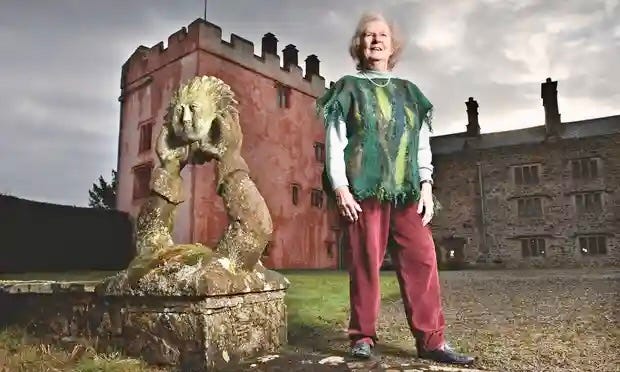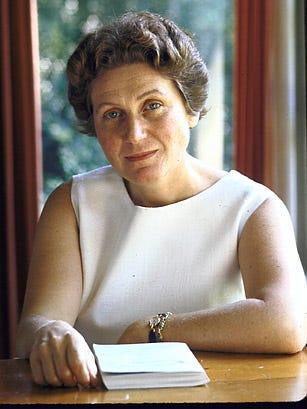Why nobody dared say no to Mary Burkett
Friend to Stalin's daughter, unrelenting champion of Percy Kelly, Shiela Fell and Kurt Schwitters, this egotistical whirlwind put Cumbrian arts on the map
Not every regional arts administrator can boast of being shot at by the Turkish security police. Or becoming close friends with Joseph Stalin’s daughter, Svetlana Alliluyeva. Nor have many of the breed moved into a leaky 14th century pele tower and spent years renovating it.
But Mary Burkett was not a run-of-the-mill person. With her shock of red hair, enormous energy, and sense of fun she was a remarkable, if formidably eccentric, woman.
She was an author, adventurer, museum curator, historian, and internationally acclaimed authority on felt making. In her sixty-year career as a champion of the arts in Cumbria, Mary made Kendal’s Abbot Hall a premier gallery for the high arts in Britain, and created the more folk-oriented, Museum of Lakeland Life and Industry.
But, much more importantly, she helped establish the reputations of a string of important artists. They included Aspatria’s Sheila Fell, one of the 20th Century’s best landscape painters, the visionary Workington printmaker Percy Kelly, and she rescued the reputation of exiled German artist Kurt Schwitters, now seen as the hugely influential inventor of pop art, who found refuge from the Nazis in Ambleside.
It is naive to imagine that Cumbria would have gained recognition for its contemporary artistic meteors without the tenacious, strident, and even annoying advocacy from self-appointed experts like Mary. Her qualifications for presenting herself as a cultural arbiter were pretty thin on paper.
But as BBC presenter and novelist Melvyn Bragg declared in her funeral eulogy, she was a remarkably efficient autodidact who made herself the mistress of several useful professional specialities. Professionally, she was an arts and crafts teacher. Art was “the foundation of life” Mary frequently declared, “Everyone’s mind needs art whether they know it or not.”
What she apparently meant by that statement was that art helps people process their emotions and understand their surroundings. It helps them see the bigger picture of the human condition. When she spoke of “everyone” she included working class people who would not regard themselves as highbrow.
They were, for example, the 12,500 people who queued up in Carlisle from July 2017 to view the austere, intensely direct images of workaday Cumbria produced by Percy Kelly which bypass the intellect and speak straight to the feelings.
It is customary when writing the biography of a major public figure to polish their halo a little. But the truth is that Mary, who died aged ninety in November 2014, was not always very nice. Margaret Thatcher always distinguished between “smooth” people who achieved little and “crunchy” ones like herself for whom diplomacy and compromise took second place to achieving something. For good and ill, Mary Burkett was a bit crunchy.
Her close colleague, art historian David A Cross, was candid: “Mary Burkett displayed wit, good humour, kindness, drive, and a great zest for life, but she could be intimidating, sometimes bullying her staff in her drive for particular goals.
“People or objects were assessed and divided into the ‘good’ or the ‘useless’ and ‘there was no middle way’. That she was very keen to be thought of as distinguished, was a reflection of her surprisingly deep-seated insecurity,” he wrote. For example, she commissioned Cross to edit a scholarly edition of the gorgeously illustrated letters Kelly sent to her. The volume, “Dear Mary, Love Percy: A Creative Thread,” was later named Lakeland Book of the Year.
Impatient to hold it in her hands, she made the process of creation difficult. She memorably declared of the text, every word of which was written by Kelly and decorated with magnificent pictures of trawler boats, steamships, and swans: “don’t worry about the Kelly details, this book is about me !”
There was a stunned silence in the room. Mary irritated Percy’s other ardent supporters by behaving as if she somehow “owned” the artist. Sadly, the Cumbrian cultural community is still divided over whether her influence was always beneficial and there were some very prominent artists who, after a while, could not bear to be in the same room as her.
One problem was that, although she did encourage people, Mary was weirdly prone to take the credit for the efforts of others. When she died, many of the newspaper obituaries carried photographs of her clutching another large volume which she called “my book” which in fact had been written by someone else.
Where did that self-doubt and compensating desire to hog the limelight come from? Quite possibly from her unease about her class origins.
This is an extract based on a chapter from a new book, The Trophy at the End of the World. You can buy it instantly here:
: https://www.fletcherchristianbooks.com/product/the-trophy-at-the-end-of-the-world
Or you can pick up a copy from the New Bookshop, Main Street, Cockermouth, Bookends in Keswick or Carlisle and Sam Read in Grasmere.
Keep reading with a 7-day free trial
Subscribe to Hidden Cumbrian Histories to keep reading this post and get 7 days of free access to the full post archives.






